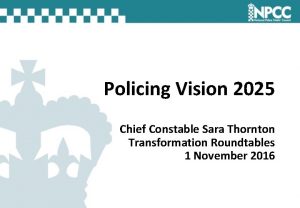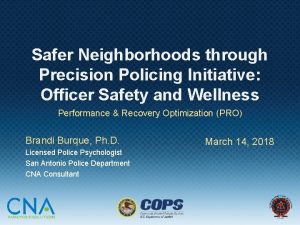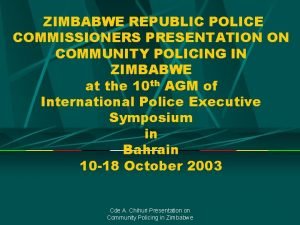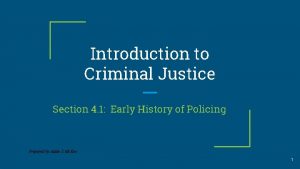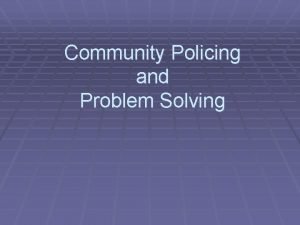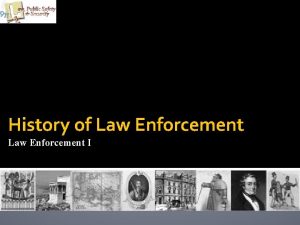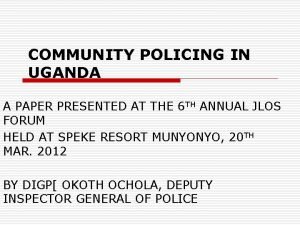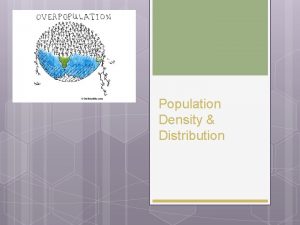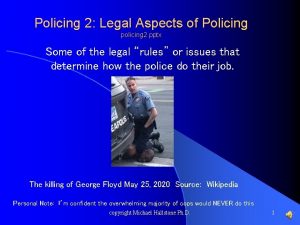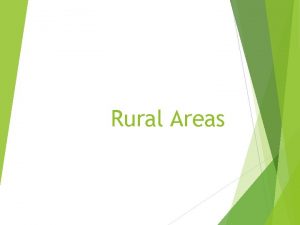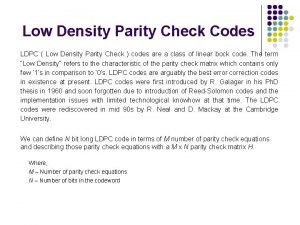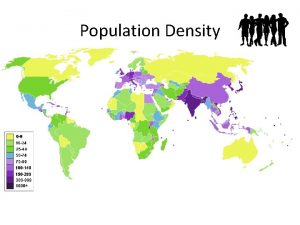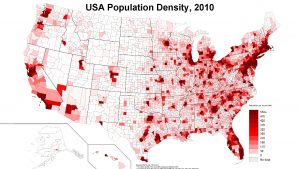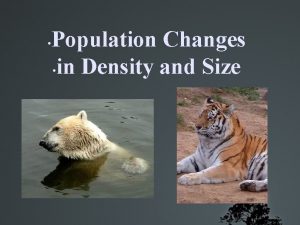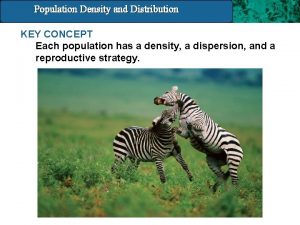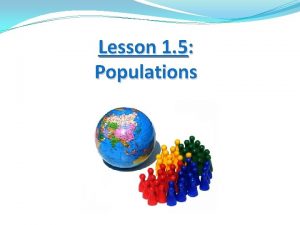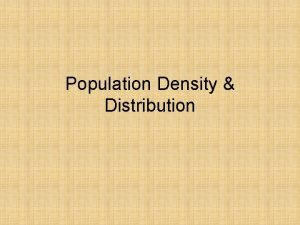Policing low population density areas in Canada JeanPaul

















- Slides: 17

Policing low population density areas in Canada Jean-Paul Brodeur Director, International Centre for Comparative Criminology

Policing low population density areas in Canada INTRODUCTION: OUTLINE OF PRESENTATION 1. Background: great differences between sparsely populated areas in Canada and in Columbia 2. General notions 3. The RCMP and unpopulated areas 4. The present situation 5. Conclusions

Policing low population density areas in Canada BACKGROUND Canada Columbia 1. Northern territory 2. Freezing temperatures 3. Inhospitable ― equipment needed 4. No possibility of insurgent bases 1. Southern territory 2. Warm or temperate climate 3. Survival without heavy equipment 4. Possibility of insurgent bases Conclusion: great difficulty of applying Canadian police experience to Columbia

Policing low population density areas in Canada GENERAL NOTIONS: MODELS OF POLICING 1. Community mediation 2. Collective community enforcement 3. The military (Antiquity ― Middle Ages) 4. The police (1692, 1829) 5. Delinquent orders (mafia, warlords, etc. )

Policing low population density areas in Canada GENERAL NOTIONS: HISTORY OF POLICING 1. 1692: initial birth in France: general governance 2. 1829: re-invention in England: crime prevention 3. Urban setting: the policing of strangers 4. Police alternative to military Conclusion: idea of rural policing problematic in itself (almost no research)

Policing low population density areas in Canada GENERAL NOTIONS: THE POLICE AND THE ARMY Police Army 1. Ethos: minimal force 2. Target: delinquent citizens 3. Part of civil society (same rules) 4. High accountability 1. Ethos: overwhelming force 2. Target: enemies of the state 3. Outside civil society (own rules) 4. Low accountability Conclusion: militarized police vs. military police (police ethos + military firepower)

Policing low population density areas in Canada GENERAL NOTIONS: CONDITIONS FOR POLICING 1. Pacification 2. Basis in communities 3. Legitimacy 4. Positive symbolism 5. Primacy of authority over use of force 6. Authority: security through visibility 7. Use of force: security through coercive action

Policing low population density areas in Canada THE RCMP: CANADIAN GEOGRAPHY AND HISTORY

Policing low population density areas in Canada THE RCMP: ITS HISTORY 1. Created in 1873, following acquisition of Rupert Land (6, 000 square km) 2. Two detachments of 300 men: military organisation 3. Mission: ensuring peaceful colonization of Canadian West 4. Major achievement: soft control of aboriginal tribes (1873 -1879) 5. Major achievement (2): policing the Yukon gold rush (1894 -1898) ― RCMP as emergency service 6. Birth of RCMP myth 7. Reputation for incorruptibility 8. 1920: RCMP becomes Canada’s national police, except in Ontario and Quebec

Policing low population density areas in Canada THE RCMP: DATA ON UNPOPULATED AREAS 1. Northwest Territories A. 1, 136, 106 km 2 B. Population: 42, 944 / 0. 06 person/km 2 C. GDP per capita: 94, 953$ 2. Nunavut A. 2, 093, 190 km 2 B. Population: 30, 245 / 0. 01 person/km 2 C. GDP per capita: 36, 400$ 3. Columbia A. 1, 138, 810 km 2 B. Population: 43, 593, 035 / 38. 27 person/km 2 C. GDP per capita: 7, 900$

Policing low population density areas in Canada THE RCMP: MANDATE 1. Structure of policing in Canada 2. Contract policing 3. Community policing Social and preventive policing • Law Toenforcement provide healthy alternatives, especially for youth Towork provide policing in a authorities culturally and • A. to together withservices community appropriate manner agencies Tobe maintain andwith security • B. to involvedpublic in thesafety schools a view to educating children about healthy ways to live • to make regular, personal contact with as many community members as possible • to engage in the life of the community • to work with the community regarding public awareness and crime prevention

Policing low population density areas in Canada THE RCMP: CRIME IN UNPOPULATED AREAS Offence % of Victimizations (n = 175) Vandalism Theft/attempted theft of personal/household property 29 % 22 % Motor vehicle (including snow machine) theft Break and enter Robbery Assault Sexual assault 7% 13 % 6% 15 % 8%

Policing low population density areas in Canada THE RCMP: AREAS OF DISSATISFACTION Area of dissatisfaction Not dealing enough with drug/alcohol issues Lack of police presence/visibility Response time too slow/do not come when called Youth crime problems/too lax with young offenders Could not get help from RCMP when needed Seem unwilling to investigate Don’t help with things that they should help with Go out of their way to deal with minor offences Demeanour of officers less than respectful/uncaring Not enough resources/manpower %(n = 330) 17 % 13 % 11 % 8% 8% 8% 6% 6% 5%

Policing low population density areas in Canada THE RCMP: POLICE RESPONSE Police response Yes No Listen carefully to you 43 13 Clearly explain what actions they would take 28 19 Offer any sort of assistance to you 28 25 Offer any suggestions to prevent repeat of the crime Refer you to Victims Services 18 9 30 Discuss the possibility of referring your case to your Community Justice Committee 6 34 23

Policing low population density areas in Canada CONCLUSIONS: THE COLUMBIAN SITUATION 1. Uncertain pacification 2. War against drugs 3. Neglect of other duties of protection 4. Unpopularity of measures (war against drugs) 5. External influence 6. Inconsistency

Policing low population density areas in Canada CONCLUSIONS: LESSONS TO BE LEARNED 1. Columbian rural territories are “rural” just in name (high violence, low-intensity conflict) 2. Traditional models of rural policing do not generally apply 3. Managing the transition from the military to the police requires preconditions, in addition to pacification: A. common will of the police and the military B. consistency of action C. dedication to the public’s interest D. transparency (covert agenda, corruption) E. legitimacy F. trust G. acceptance

Policing low population density areas in Canada THANK YOU FOR YOUR ATTENTION MUCHAS GRACIAS
 High density low density
High density low density Physiological density
Physiological density Linear density bcc
Linear density bcc Linear density of fcc 110
Linear density of fcc 110 Why is arithmetic density also called crude density?
Why is arithmetic density also called crude density? How to compute for specific gravity
How to compute for specific gravity Low packing density
Low packing density Introduction of community policing
Introduction of community policing Scottish institute for policing research
Scottish institute for policing research Police vision 2025
Police vision 2025 Snppi
Snppi Community policing
Community policing Kin policing
Kin policing Community policing
Community policing Pharaoh hur moheb
Pharaoh hur moheb Community policing in uganda
Community policing in uganda 9 policing principles code of ethics
9 policing principles code of ethics Backbone of police department
Backbone of police department









